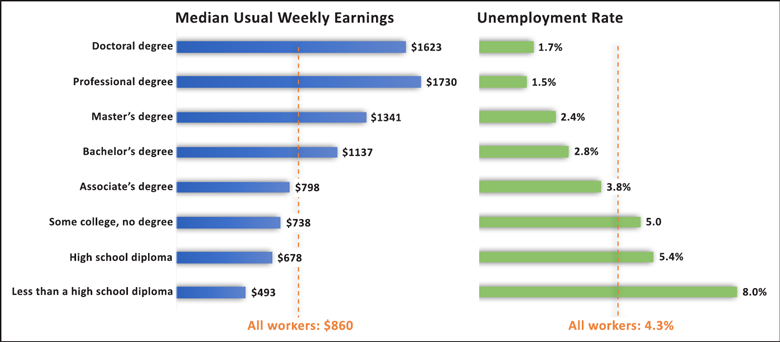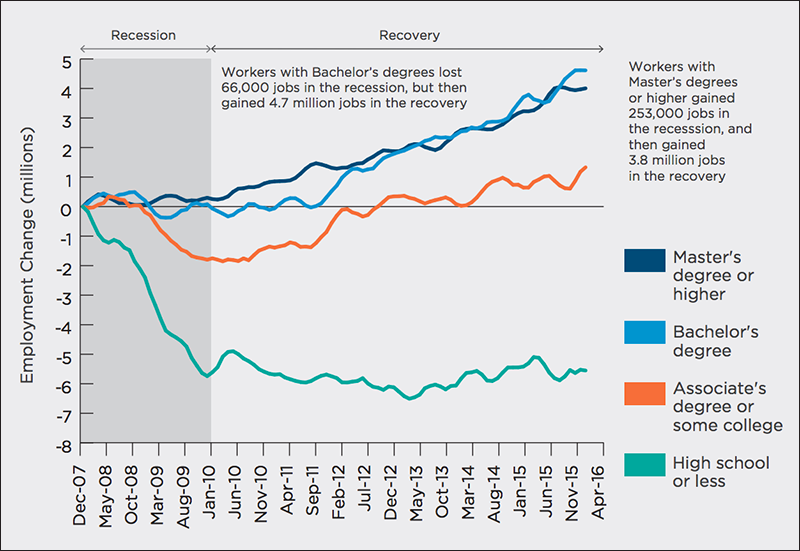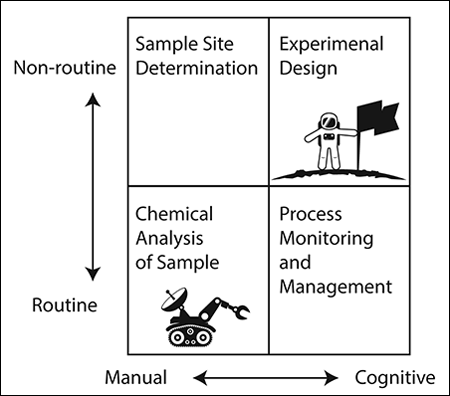Prediction is difficult, especially about the future.
—Niels Bohr
The year 2017 promises to be a time of political turbulence and change. New leaders have been elected or have come to power by other means in several countries. Conflict rages on in many regions, and the global economy continues to equilibrate. In the United States and most European countries, large portions of the population are pushing back against social and economic changes that they perceive to be in their disfavor, resulting in protectionism and opposition to globalization.
Employment in the United States this year should stay about the same as in 2016.
What do these political and socioeconomic changes mean for the job market?
In the short term, probably not much. Employment in the United States this year should stay about the same as in 2016 because we expect the U.S. gross domestic product (GDP) to stay about the same.
But, in the decade to come, a few employment trends are likely. Here are seven things to expect as the future unfolds.
1. No Huge Employment Changes Are Likely in the United States for 2017
Governments and bureaucracies are built to protect the status quo, not to promote change.
Yes, there will be much political rhetoric and many governmental/policy changes in 2017. However, governments and bureaucracies are built to protect the status quo, not to promote change.
In economics, the relationship between unemployment and economic growth is described by Okun’s law. Arthur Okun, a former chair of the Council of Economic Advisors (1968–1969) and Yale economist, found that for every 1% increase in a country’s unemployment rate, there is an approximate 2% fall in the country’s GDP.
Major economists—from Forbes, Goldman Sachs, Edward Jones, and Wallet Hub—predict that the U.S. GDP will continue modestly upward at a feeble pace toward a growth target of 2.2% to 2.5% in 2017.
Although that is nothing to party about, it is not apocalyptic. Thus, we can predict a steady state for U.S. employment, in accordance with Okun’s law.
2. Trends in Other Countries May Not Be Applicable to the United States
European economies will continue to improve slowly throughout 2017, as will most of the emerging economies, including China. Economic growth in China is predicted to slow but will likely meet their published goal of +6.5% for the GDP.
But it’s important to note that employment statistics for most other countries are not directly comparable to ours. Granted, employment in Europe is expected to increase modestly, but employment is not easily defined for developing economies where independent subsistence is more common than working for money or for communist countries where everyone is, technically, employed.
3. People with Advanced Degrees Will Fare Better
The average 2015 unemployment rate for Ph.D.’s in the United States was 1.7%, and the rate for people with a high school diploma or less was 8.0%. The overall average unemployment rate for 2015 was 4.3%, which is about as good as it gets for the general population.
So, similar to past years, those with a higher education degree had much less unemployment and made more money than those without one. [Insert sigh of relief.] People with advanced degrees, especially in the Earth and space sciences, fared particularly well (see Table 1).
| Table 1. Occupational Outlook and Salaries for Selected Earth and Space Science Occupationsa | |||
| Occupation
| Required Entry-Level Education | 2015 Median Salary (US$) | Projected Growth Rate: 2014 to 2024 |
| Astronomers | Ph.D. | $111,000 | 7%, average |
| Atmospheric scientists, including meteorologists | Bachelor’s | $90,000 | 9%, above average |
| Chemists | Bachelor’s | $73,000 | 3%, below average |
| Environmental scientists | Bachelor’s | $67,000 | 11%, above average |
| Geoscientists, except hydrologists | Bachelor’s | $90,000 | 10%, above average |
| Hydrologists | Bachelor’s | $80,000 | 7%, average |
| Mining and geological engineers | Bachelor’s | $94,000 | 6%, below average |
| Petroleum engineers | Bachelor’s | $130,000 | 10%, above average |
| Professors | Ph.D. | $72,000 | 13%, above average |
| All physical scientists | $76,000 | ||
| All occupations | $36,000 | ||
| aData are for persons age 25 and over. Earnings are 2015 annual averages for full-time wage and salary workers. Credit: U.S. Bureau of Labor Statistics (12 January 2017) |
Those years of study to gain an advanced degree really were worth it in the end.
Although the full accounting of data isn’t in yet, 2015 trends likely continued in 2016. The U.S. unemployment rate was 4.7% in December 2016.
I have received many questions from job seekers about the way too common perception that people with advanced degrees have a harder time finding employment than those with lower-level degrees. As can be seen from the figure, the higher the level of attainment is, the lower the unemployment level is.

In the Great Recession of 2008, when the U.S. manufacturing sector lost more than 2.7 million jobs, 1.6 million were lost by people with a high school diploma or less. In the economic recovery period that followed, people with no college training gained back only 214,000 jobs out of the total 1.7 million created. Many workers in lower-skilled jobs were replaced by technological efficiencies: robots, drones, and algorithms.
Without a doubt, the recession created an even greater divide between those with a high school diploma or less and those with at least some college education. I offer this as further proof that a college education is necessary for success in the modern economy.

4. Employment in Earth and Space Science Research: Cloudy with a Silver Lining for Some
The employment outlook for the Earth and space sciences is still quite good compared to most professions. Both the U.S. Bureau of Labor and Statistics and the American Geosciences Institute predict high demand in most fields.
However, these employment reports were compiled prior to the election of incoming President Trump. Thus, predictions related to jobs in energy and environmental monitoring, regulation, and policy are likely inflated, especially for government agencies and academic positions. The incoming administration is, instead, leaning heavily toward practices and policies that favor U.S. businesses.
Private foundations and industry may offer some measure of safety in the coming storm.
With that in mind, it’s very possible that federal funding for climate change research could take a hit, which would affect not only federal agencies but also the university researchers who depend on that funding. It is possible that private foundations and industry may offer some measure of safety in the coming storm.
Taking shelter with state agencies may be a mixed bag. Already, some states, such as California, are vowing to step in to support climate change research regardless of what the federal government does. However, other states have been feeling a squeeze in all areas of geoscience research for some time now.
5. Government Jobs Will Start to Be Privatized
Business-oriented administrations favor the use of private companies for operations and services traditionally provided by government agencies. This does not necessarily mean that the net need for specific services will go down.
For example, although some regulations may be lifted for private businesses, there will still be a need for environmental specialists in many fields. Most large companies are global and thus will still need to meet regulatory policy requirements in all of the countries where they have operations and sales. Thus, the service of providing environmental assessments will still have a place.
Privatization may be of benefit to new graduates looking for entry-level positions.
Although privatization puts existing federal workers at risk, it may, in fact, be easier for job seekers to gain employment with contracting agencies than to apply through the federal hiring process. So privatization may be of benefit to new graduates looking for entry-level positions.
Most existing federal regulation jobs will likely remain, but budgets could be cut significantly. Hiring freezes may also be common in the future, as a way to decrease the size of the government workforce through attrition. Because 25.5% of all nonseasonal full-time permanent federal employees are currently eligible for retirement, not hiring replacements for recent retirees may be one way of downsizing.
In other words, regulation watchdogs will still be present, but they won’t be well fed.
6. Automation Is Here to Stay

If a robot on Mars can do your job, you may need to worry.
Massachusetts Institute of Technology economists Daron Acemoglu and David Autor detail the kinds of jobs that are more likely to be filled by a robot or a computer algorithm rather than a more expensive and more demanding human. Humans still have the edge for nonroutine jobs requiring creativity.
The key is to learn enough so that you can use technology as a tool. When you become the tool, you can easily be replaced. Don’t be a tool.
Since technology continues to evolve, so should you. X-ray diffraction was once a technique requiring a skilled professional. Today, a semiautonomous robot on the other side of the solar system can collect samples and analyze them remotely.
7. Opportunities Will Rise in the Gig Economy
The use of contractors, consultants, and freelancers is much more common today than it was a decade ago, and this trend is expected to continue. From the employer’s perspective, contract arrangements allow for greater workforce flexibility and lower costs. Although the base salary for a contractor may be slightly higher than for a full-time employee, the overall cost to contract may be cheaper because contractors generally do not qualify for health insurance or other benefits.
If employment based on government funds is expected to go down, contractors will likely fill the void. Contractors are present in all sectors of employment, including industry, academia, and government.
Holding multiple contracts may be the new modus operandi of the now and future worker.
For example, opportunities to work as technical writers, geological surveyors, or in any other area with easily defined deliverables will likely increase. In academia, there has been a growing trend for the use of instructors and adjunct faculty to cover course loads. This trend will likely continue.
Holding multiple contracts may be the new modus operandi of the now and future worker. Although this is not as stable as full-time employment, it does give the worker flexibility to pursue several opportunities, gain varied experiences, keep skills fresh, and build a wide network of possible future employers.
Back to the Future
No one knows what the future truly has in store, but being aware of expected trends and adapting to changing conditions are your best strategies for success. As you set your goals for 2017, here are some suggestions to build your adaptability skill set:
- Learn something new every day: Keep your mind sharp and flexible.
- Be aware of your surroundings: Stay on top of changes to your field, your sector, and society; know your options and the risks to your employment and success.
- Have a plan for your success, and update it as situations change: Let the little stuff go, so that you can focus on what is most important to your success.
Change is the only constant in life. Plan on it always being there, and live your life accordingly.
For more career advice or to see listings of jobs available in the Earth and space sciences, visit the AGU Career Center at careers.agu.org.
—David Harwell (email: [email protected]; @deharwell), Assistant Director, Talent Pool, AGU
Citation:
Harwell, D. (2017), Seven projections for Earth and space science jobs, Eos, 98, https://doi.org/10.1029/2017EO066469. Published on 18 January 2017.
Text © 2017. The authors. CC BY-NC-ND 3.0
Except where otherwise noted, images are subject to copyright. Any reuse without express permission from the copyright owner is prohibited.

